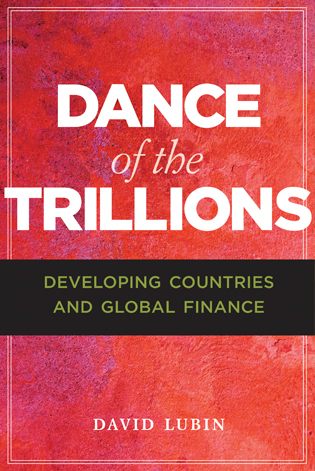Turbulent Times

Dance of the Trillions
Developing Countries and Global Finance
Brookings Institution Press/Chatham House, Washington, DC, and London,
2018, 154 pp., $34.99
I have admired and followed David Lubin for many years in his role as one of the leading emerging market strategists. In a world of often jarring ups and downs in the markets—2018 with its violent emerging market sell-off is a good illustration—David’s calls and analysis have brought insight and perspective to often turbulent times.
Dance of the Trillions traces the ebb and flow of global capital to emerging market and developing economies from the 1970s to today, and it does so in an all-encompassing and well-written manner. Along the way, the book touches on the curse of hot money for many emerging markets, the illusion that managing exchange rates will somehow provide stability (when the opposite is so often the case), and the central role of US monetary policy as one of the principal drivers of capital flow cycles to emerging markets. The latter point is especially pertinent today, given that we stand at the tail end of a decade of extraordinary monetary stimulus that is, ever so gradually, being unwound.
Besides China’s rising influence, emerging markets face a stream of challenges that will shape the coming decades. First, there is the shift toward protectionism in some advanced economies, which itself is rooted in a perception that globalization perhaps bestowed too many benefits on emerging markets at the expense of low-skilled labor in the advanced world. Second, there is the unstoppable march of technological progress, which may make low-skilled jobs increasingly obsolete. The 3D printing of running shoes is one example of the return of production from emerging markets to advanced economies as a result of the diminishing importance of wage differences. Some people have called this effect perhaps the biggest challenge for emerging markets. Third, the overhang from a decade of extraordinary monetary stimulus in the world’s three leading economies produced record capital flows to emerging markets and thus, perhaps, record vulnerabilities.
The central question the book raises—which all of us in international finance debate regularly—is the role China will play in the world economy in the years ahead. Recent trade tensions between the United States and China are symptomatic of persistent imbalances and a reluctance to address them on all sides.
There’s a separate set of issues, perhaps outside the scope of Lubin’s book, around the geopolitics of going from a US-centric unipolar world (of which the so-called Washington Consensus was an outgrowth) to a more bipolar or multipolar world—and where this leaves China and the rest of the developing world. The mixed reactions to China’s Belt and Road Initiative, especially around debt and the lack of knowledge transfer in recipient countries, reflects a larger issue: whether China’s business model may face as much, or more, scrutiny as the Washington Consensus.
Opinions expressed in articles and other materials are those of the authors; they do not necessarily reflect IMF policy.








